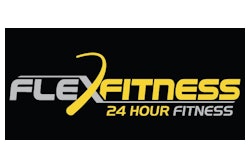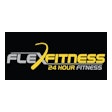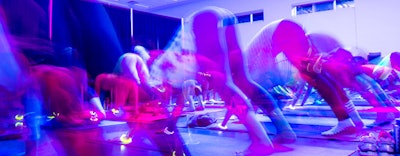
Neal Pire has spent more than 30 years designing, managing and consulting for fitness and training centers, including the development of fitness programs. Also serving on the NSF International Joint Committee on Health Fitness Facility Standards, Pire has seen a lot of good and bad facility design.
Unfortunately, his current position as medical wellness implementation specialist at HNH Fitness in Oradell, N.J., leans a little more toward the latter category. "The design is very hospital-like," says Pire of the seven-year-old medical wellness facility. "As far as lighting is concerned, this is not your model facility. It can be described as cold and sterile, and the lighting itself does not lend itself to a warm environment."
The success of a fitness business hinges on retention and keeping users coming back, which, in turn, means keeping them motivated. The right lighting can make or break it. "But the nice thing is you change that by changing the lighting," he adds, noting that the facility is currently undergoing a renovation that will address the lighting issue. "You can redesign a room to get the mood and response you want from your participants by changing nothing but the lighting. It can motivate or it can subdue. It has a very powerful effect."
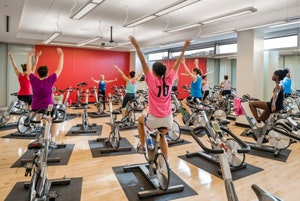 (Photo By Anton Grassl/ESTO)
(Photo By Anton Grassl/ESTO)
MOOD & MOVEMENT
The relationship between lighting and mood is already established and part of basic building design. Most facilities aim to incorporate as much daylighting as possible, in part because of the energy efficiencies but also because of its mood-enhancing effects. "Natural lighting has a positive effect on your alertness," Pire says. "The more alert you are, the more energized, the more with it."
Brighter colors further enhance that alertness, Pire adds. "If you have a big room and you're doing a high-intensity workout like aerobics or a boot camp, and you use bright-colored lighting — yellows, oranges, things that are going to energize — you will get that more intense effect."
To boost this effect, the lights might also be programmed to change color or intensity, or be paired with high-energy music, video — or both. "Creating that club environment where they have a DJ, that's what's trending, especially in cycling," says Grace DeSimone, editor of the American College of Sports Medicine's Resources for the Group Exercise Instructor. "Some studios have a dance-club feel using disco balls, gel-colored lighting, black lights, neon lights and more elaborate lighting that is synced with the music via computer for an entertainment effect."
Alternatively, to create a more calming environment, softer lighting is the way to go. "In yoga and meditation, the lights are ambient and dimmed to provide a relaxed mood," DeSimone says. "Battery-operated electric candles are increasingly popular and set the tone for indulgent restoration. You can also use gel lighting to create softer lighting or wall sconces to create ambient lighting."
Then, of course, there's complete darkness. "You go into some group cycling rooms, they do everything in the dark," says Pire. "That's okay if you're setting the mood, getting into your own head and 'living the ride,' as they say, but you're not going anywhere."
That's an important distinction. ACSM offers some basic recommendations for facility lighting — such as a minimum of 50 foot-candles of lighting throughout the facility and adjustable lighting controls — aimed at ensuring users' safety. "Where there is more movement, there needs to be more light," DeSimone explains. "In a boot camp class or high-intensity class, bright lighting is imperative to see the activity and to avoid injury. But at the end of class, once everyone is relaxed and seated on a mat, dimming the lights for a cool-down and stretch can be a calming experience."
In cycling classes where participants remain on their bikes and don't physically interact, and classes such as yoga and Pilates, darker lighting is acceptable during the workout, but the instructor still needs to be able to bring the room back to full brightness. "Rooms should never be plunged into complete darkness," warns DeSimone. "There should always be running rights on the floor to illuminate the walkway and exit in the event of an emergency or in the event a student needs to leave during a class. Instructors are often in control of the dimmable lights and need to be cautious about providing enough illumination for students to see what they are doing. If the lights were dimmed during relaxation, instructors should gradually illuminate the room so students can exit safely."
In recreation centers, as well, design should consider non-fitness-related uses. Group exercise rooms are more often thought of as multipurpose rooms — accommodating meetings, party rentals, dances, educational classes and more.
"Don't forget cleaning," DeSimone adds. "You still have to clean the bikes and the floor, and you need to be able to see what you're doing."
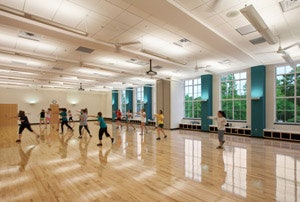 (Photo © Hastings+Chivetta Architects Inc./Fentress Photography)
(Photo © Hastings+Chivetta Architects Inc./Fentress Photography)
UNDERSTANDING DESIGN
The perception of light can be augmented by the design of the surrounding environment. "One of the first recreation center jobs I did, the thought that came to my mind was dark, concrete," recalls Eric Nielsen, an associate with Architecture Engineering Design Group Inc. of Denver. "For architects today, it's about color and movement."
The interaction between lights and the ceiling is particularly important, and you don't have to be lying on your back to notice it. "As the ceiling gets brighter, it appears higher, and you get that perception of space that may not actually be there," Nielsen says. "If you have a ceiling with a bunch of down-lights set in tight cones, that puts down a lot of horizontal light, but the ceiling itself is dark."
Combining different lighting techniques allows light to be better distributed. One technique that used to be popular was the perimeter cove, says Nielsen, which created an indirect light source close to the ceiling. "The circular cove went away for a long time," he says, noting its initial cost and energy requirements. New technology — namely, LED lighting — has brought them back into vogue. "By moving to LED, it's more energy efficient, and we have better dimming control and fewer ceiling issues."
The activities taking place in the group exercise space have also led to some design changes. Drop ceilings, once a standard in the group exercise room, are going away, deemed impractical for some of the more chaotic activities currently popular. "For movements where people are throwing and catching sandbags and medicine balls, you don't want to worry about hitting the ceiling," DeSimone says. "I go into some studios and think, 'Okay, there won't be any jump ropes in here because the designer got really fancy and there's drop lighting.' It's really beautiful, but we can't use ropes or throw balls."
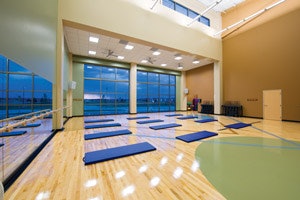 (Photo By Ed Lacasse Photography)
(Photo By Ed Lacasse Photography)
TAKING CONTROL
It's one thing to understand how the right settings can enhance an environment; it's another to make it happen. "The control system needs to be easy to use so that different instructors can come in and understand what they're doing," says Vannessa Pederson, a designer with Architecture Engineering Design Group. "Whether it's a push button that we have labeled 'yoga' or a slide dimmer that they can use to tune their own lighting, instructors don't want to come into a room and have to deal with a huge switch bank and no labels."
If nothing else, lights in an exercise room should be dimmable. From there, Nielsen recommends having different types of lights that can be turned on and off independently. "We try to do systems where instructors can turn off the direct lighting and use the indirect portion to create a low-glowing atmosphere," says Pederson. "Then, for aerobics, you can pump up all those lights — direct and indirect — and have light going in all directions. You can see what the instructor is doing and easily identify visual cues."
Some additions can be pretty simple and inexpensive for facility owners or group instructors to do themselves. " You can purchase a disco ball or colored, rotating lights online," says DeSimone. "Some people buy rope lighting and line a mirror. That's their mood lighting and their done."
For facility owners not looking for choreographed, dance-club style lighting systems, the cost of a programmable control panel is fairly reasonable, but for the more complex choreographed lighting and A/V systems, however, costs can reach into the tens of thousands of dollars, incorporating elements such as blackout curtains, sound amplifiers and video screens. "There's a premium for touchscreen system integrated with audio," Pederson says. "The more integrated the system, the more expensive."
RELATED: Carefully Planned Aesthetic Lighting Techniques Becoming Top Priority
RELATED: The 'Issue' Is Facility Design
RELATED: Fitness Programming Changing the Way Group Ex Rooms Are Designed
RELATED: Sky's the Limit
A BRIGHTER FUTURE
There was a time before LEED and green building design when lighting in fitness centers looked drastically different. "When I first started, if you could afford the fixture dollar-wise, you could do a lot of fun things," says Nielsen. "But as energy codes got more stringent, our designs got more stringent. Indirect lighting became much more difficult for us — to throw light up at the ceiling and have it bounce back, you're guaranteeing 20 percent inefficiency. We had to find other ways to create that effect, like using fixtures that are primarily direct but put some light onto the ceiling."
Efficiency — minimizing energy usage and operational costs — became a priority in lighting design, with little tolerance for anything that decreased those efficiencies. "You can almost draw a line where the energy codes started to take off," says Nielsen. "I think the first rec center I did, we came in at 2.2 watts per square foot. Now we're coming in at 0.9."
The design pendulum has begun to swing back, thanks in large part to the increased efficiency and affordability of LED lighting. "Five years ago, the efficiency of LEDs wasn't blowing fluorescents out of the water," says Nielsen. "Now it exceeds fluorescents, and you have LED arrays that are not just dimmable and color-temperature controllable, but notably more efficient."
"Maintenance people really like the long life of LEDs," adds Pederson. "You don't have as many lamp outages, which makes the facility as a whole look more kept up."
The design possibilities are further opened up by myriad options in terms of LED size, color and intensity. "We can fit a lot of LEDs into areas we just didn't have the ability to with more traditional sources," Pederson says. "They have more shapes — bending, recessed, curved lines in the ceiling. Whereas before we might have been stuck with a warm light, we can go with a bluer light in an area that has a lot of daylight and try to match that."
The options created by new and evolving LED technology paired with the increasing popularity of boutique studios and immersive fitness programming should be enough reason for any facility owner to rethink his or her lighting design. And while a unique lighting design can become a signature element of a fitness facility, DeSimone adds one final note of caution: "There's something for everyone, and for everyone who likes it, you'll find someone who doesn't."
This article originally appeared in the May 2015 issue of Athletic Business with the title "Light Exercise"















